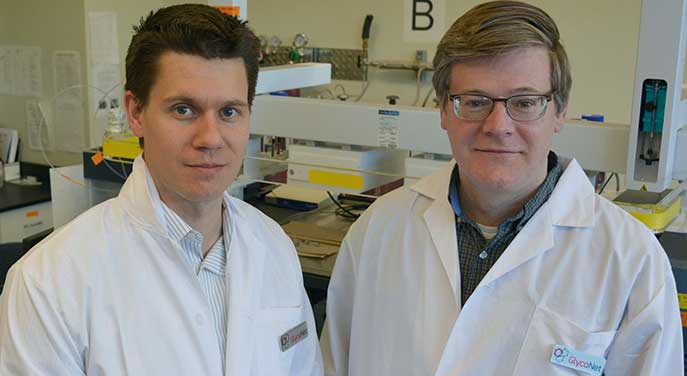
Chemists Matthew Macauley (left) and John Klassen led new research that is among the first to show that the SARS-CoV-2 coronavirus uses sugars found on the surface of human cells to enter and infect the cells. (Photo: Faculty of Science, University of Alberta)
Sugars found on the surface of human cells influence COVID-19 infection, according to a University of Alberta-led study that’s one of the first to observe this relationship and suggests that cells in the brain might be particularly susceptible.
“The idea here is that the virus is leveraging or using the host glycans, or the host sugars, to gain access to the cells,” said Matthew Macauley, professor in the Department of Chemistry and Canada Research Chair in Chemical Glycoimmunology. “This mode of action of viral entry is not unprecedented,” he said. “What is a surprise, though, is that it hadn’t really been detected.”
These sugars, known as glycans, are made of sialic acid and a class of biomolecules that are essential for cell structure, energy storage and system regulation.
Macauley explained that up to 50 percent of all viruses that infect our cells, the most well-known of which is influenza, bind to sugars on cell receptors to gain access and infect the cell.
“That’s what all of our cells have on them, so why not exploit what’s there – that’s what viruses are good at,” he said.
The study was initiated by John Klassen, professor of chemistry in the Faculty of Science, whose lab developed the analytical tools to screen glycans. Specifically, Klassen and co-workers used a mass spectrometry technique, called catch-and-release, to study what sugars interact with the spike protein of SARS-CoV-2.
After that, Macauley and European collaborators started applying biological tools to see whether they could demonstrate a correlation between the viral proteins’ ability to recognize these sugars and their role in the infection process.
Macauley’s lab initially ran experiments with a relatively harmless pseudovirus, incapable of replicating in the lab, armed with the spike protein of SARS-CoV-2. After obtaining promising results, professor Tom Hobman’s laboratory in the Department of Cell Biology in the Faculty of Medicine & Dentistry replicated findings on authentic SARS-CoV-2 under appropriate biosafety containment.
The researchers used chemical biology tools to modulate those sugars on the cell surface to study the ability of the viruses to get inside and infect cells.
Though researchers have shown that the virus’s ability to infect a cell drops by between two and ten times when the production of sugars on cell receptors is blocked, Macauley suggested the process is not fully understood enough for the immediate development of a therapy.
“Because SARS-CoV-2 is constantly evolving, a variant that evolves with more sugar-dependent infection would be quite concerning, but our knowledge enables us to keep a lookout for such a variant,” he said.
How a much-needed oral antiviral drug confuses Covid-19 by Gillian Rutherford
The paper also proposes that the particular sugars the researchers were investigating – glycolipids, which are sugars attached to lipid (fat) – are found in the highest concentrations in an area where COVID-19 has been recently shown to infect: the brain.
Macauley said earlier this year, a number of studies showed that SARS-CoV-2 can find its way to the brain and infect cells of the nervous system, including neurons.
“We speculate that these sugar interactions could relate to what’s called a tissue tropism, which is the cells of the host that support viral infection and replication.”
The results from the study support similar work by one of the paper’s co-authors, Lori West, Canada Research Chair in Cardiac Transplantation in the Faculty of Medicine & Dentistry, who is trying to understand why people with blood type A are more susceptible to getting COVID-19 and are more susceptible to a more severe type of infection.
Now, with access to the variants of concern, Klassen said the team is exploring whether the variants all have similar sugar-binding properties or whether these mutations are actually leading to changes in their ability to recognize specific structures.
| By Michael Brown
Submitted by the University of Alberta’s Folio online magazine. The University of Alberta is a Troy Media Editorial Content Provider Partner.
© Troy Media
Troy Media is an editorial content provider to media outlets and its own hosted community news outlets across Canada.


